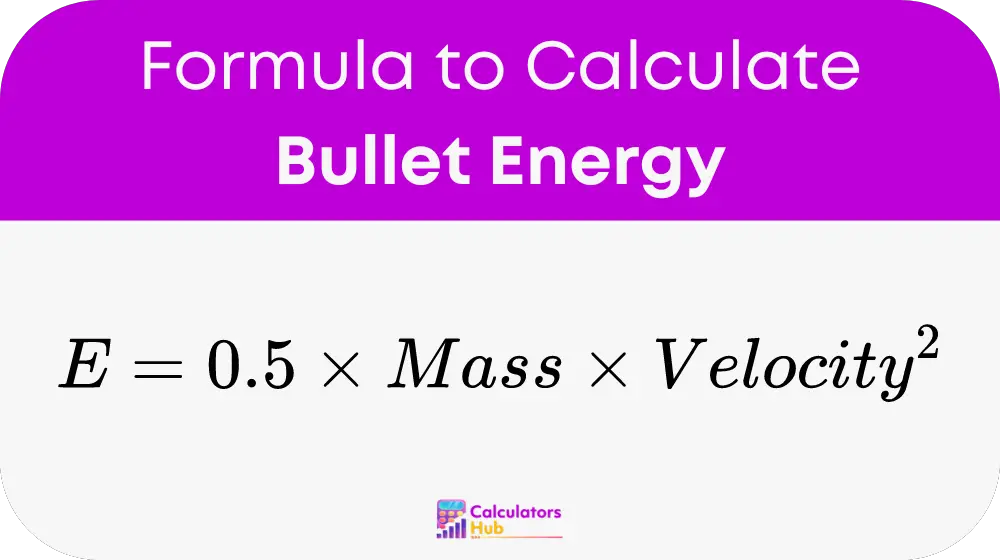The Bullet Energy Calculator is a tool that helps shooters, hunters, and ballistics experts calculate the kinetic energy of a bullet. Kinetic energy is a crucial factor in understanding the bullet’s stopping power, penetration capability, and overall effectiveness when hitting a target. By considering both the bullet’s mass and velocity, this calculator estimates the energy that a bullet carries when it is fired, helping users determine its impact performance.
This calculation is essential for selecting the appropriate ammunition for hunting, sport shooting, or self-defense. It also assists firearms manufacturers and engineers in developing ammunition with the desired energy output for specific applications.
Formula for Bullet Energy Calculation
The formula for calculating the kinetic energy of a bullet is:

Where:
- E is the kinetic energy, typically measured in joules (J) or foot-pounds (ft-lb).
- Mass (m) is the mass of the bullet, usually measured in kilograms (kg) or grains (1 grain = 0.0000648 kg).
- Velocity (v) is the velocity of the bullet, typically the muzzle velocity measured in meters per second (m/s) or feet per second (ft/s).
This formula calculates the kinetic energy of a bullet based on its mass and the square of its velocity. Kinetic energy increases significantly as velocity increases, meaning that even a small increase in bullet speed can lead to a substantial rise in energy.
Detailed Breakdown of the Formula
- Mass (m): The bullet’s mass is usually expressed in grains in the shooting world. To calculate kinetic energy in joules or foot-pounds, you need to convert grains into kilograms using the conversion factor:
m (in kg) = Mass (in grains) * 0.0000648. - Velocity (v): The velocity of the bullet is typically the muzzle velocity, which is the speed at which the bullet leaves the barrel of a firearm. It can be measured in meters per second (m/s) or feet per second (ft/s).
For those using grains for bullet mass and feet per second for velocity, the kinetic energy in foot-pounds (ft-lb) can be calculated using the following equation:
E (in ft-lb) = (Mass (in grains) * Velocity² (in ft/s)) / 450,240
This conversion allows users to calculate bullet energy in foot-pounds, which is a common unit used in shooting and ballistics in the U.S.
Quick Reference Table
Below is a table of common bullet weights, their typical muzzle velocities, and their kinetic energy calculated using the Bullet Energy Calculator:
| Bullet Weight (grains) | Muzzle Velocity (ft/s) | Energy (ft-lb) |
|---|---|---|
| 115 | 1,150 | 338 |
| 124 | 1,200 | 396 |
| 147 | 950 | 295 |
| 180 | 1,100 | 484 |
| 230 | 830 | 352 |
This table provides examples of energy levels for different bullet weights and velocities, giving users a clear understanding of the relationship between mass, velocity, and energy.
Example of Bullet Energy Calculation
Let’s go through an example to demonstrate how the Bullet Energy Calculator works in practice.
Imagine you are firing a 9mm bullet with a mass of 124 grains and a muzzle velocity of 1,200 feet per second. Using the formula:
E (in ft-lb) = (Mass (in grains) * Velocity² (in ft/s)) / 450,240
Plugging in the values:
E = (124 * 1,200²) / 450,240
E = (124 * 1,440,000) / 450,240 ≈ 396 ft-lb
In this case, the bullet has approximately 396 foot-pounds of kinetic energy when it leaves the barrel. This information is critical for determining the bullet’s effectiveness in target shooting, hunting, or self-defense scenarios.
Most Common FAQs
Bullet energy is important because it indicates how much kinetic energy the bullet carries as it travels toward a target. Higher energy means the bullet can penetrate deeper and cause more significant damage upon impact. In hunting, higher bullet energy is critical for ensuring ethical and effective kills, while in self-defense, it is essential for stopping threats quickly.
Bullet velocity has a greater impact on energy than bullet mass because kinetic energy is proportional to the square of the velocity. This means that even a small increase in bullet speed results in a significant increase in energy. For example, doubling the velocity of a bullet will quadruple its kinetic energy, making velocity a crucial factor in energy calculations.
To convert bullet mass from grains to kilograms, multiply the bullet weight in grains by the conversion factor 0.0000648. For example, if you have a bullet weighing 150 grains, the mass in kilograms is:
150 grains * 0.0000648 = 0.00972 kg
This conversion is necessary when calculating bullet energy in joules, which requires mass to be expressed in kilograms.